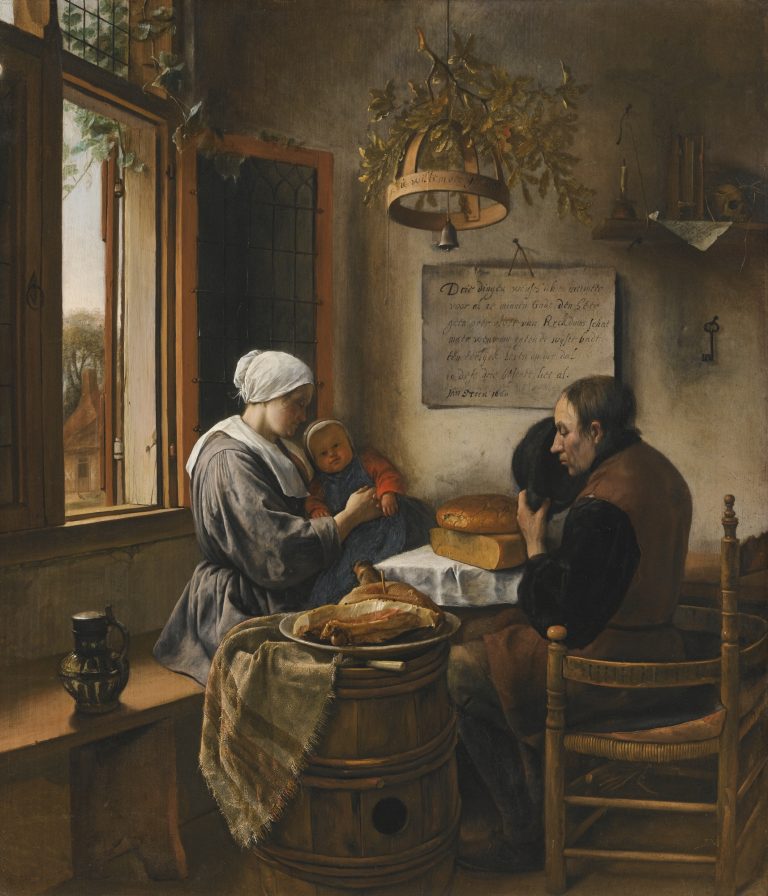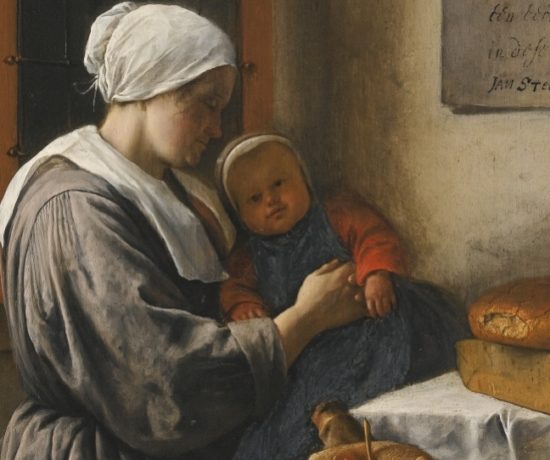This serene painting of a family praying before beginning its meal is imbued with quiet spirituality.1 A stanza from Proverbs 30:7–9 inscribed on a placard hanging on the rear wall serves as the family’s creed: “Three things I desire and no more / Above all to love God the Father / Not to covet an abundance of riches / But to desire what the wisest prayed for / An honest life in this vale / In these three all is based.” 2 The family’s plain clothes, simple furniture, bare walls, and modest meal of bread, cheese and ham indicate that they truly live by this creed. As the mother prays while cuddling her child, the father reverently holds his hat before his face.3 A key hanging behind the father symbolizes his trustworthiness.4
Inscribed on the belkroon (a wooden chandelier with a bell hanging in the middle) are words from the Lord’s Prayer: “u wille moet geschieden” (thy will be done). The father and mother remind themselves of life’s transitory nature “in this vale” by placing on the shelf an extinguished candle, a large book (probably a Bible), and a skull.5 The paper hanging over the shelf reads “Gedenckt te sterven” (Think on Death). In their faith, however, death is followed by resurrection, for a wreath of wheat crowns the skull. Wheat, which must first die and be buried in the earth before growing into a new plant, is a symbol of hope. Like the grain, man must die and be buried to achieve eternal life.6
The earliest of Jan Steen’s four representations of this subject, this scene belongs to a long-established iconographic tradition.7 Early seventeenth-century paintings and prints reflect the ideal of a pious, harmonious and fertile family life that had developed within Dutch society, an ideal also expressed in the writings of Jacob Cats (1577–1660). Protestant and Catholic families alike commissioned portraits of themselves praying before a meal.9 Artists frequently alluded to harmony and fertility by including biblical texts,10 especially the third verse of Psalm 128 (127 in the Catholic Bible): “Thy wife shall be as a fruitful vine by the sides of thine house.”11 The grapevine climbing around the window above the mother indicates that Steen also consulted Psalms. Steen’s scene resembles earlier prayer-before-the-meal images in that it includes a religious text. However, in the depiction of a humble rather than wealthy family, it differs from such prototypes. Far closer in mood and character is Adriaen van Ostade’s (1610–84) intimate etching of 1653 (fig 1), which was probably Steen’s primary compositional source.12
Neither the biblical text nor the furnishings in this humble home identify the family’s religious persuasion. While Steen’s image transcends denomination, he originally conceived the painting as a Catholic image. As has been noted for some time, a large cross, seemingly a crucifix, vaguely visible through the overlying paint, once hung above the father’s head. Steen eliminated the cross and replaced it with objects on the shelf that carry comparable symbolic associations with death and resurrection, such as the skull and its wreath of wheat, that would have been applicable to Catholics and Protestants alike.
Infrared reflectography has revealed much information about Steen’s creative process in this work, including evidence that his compositional changes were far more extensive than previously realized (fig 2). It appears that Steen initially sketched in his compositional ideas with a searching line drawn in black chalk, which he then defined more carefully with broad brush strokes.13 He repositioned a number of elements, including the window and the pitcher on the bench under the window, and added others, such as the tablecloth under the cheese. He also enlarged the back of the father’s head. Most significantly for the iconography of the painting, Steen initially conceived the composition with yet another figure: a young man situated at the back side of the table between the woman and her husband who looked up at a crucifix hanging on the wall above the praying father. Although Steen never fully worked up this figure and only blocked him in with a brush, the direction of his gaze is quite clear. The reflectogram, moreover, reveals that instead of one crucifix, as has long been thought, Steen actually painted two crucifixes, one above the other, both of which are visible in the reflectogram. The background figure would have been looking at the lower of these two crucifixes. Even though the sequence of these compositional changes is not possible to determine, the preponderance of evidence is that Steen opted to remove the explicit Catholic tenor of the scene to make it more acceptable to a Protestant buyer.
Aside from the careful thought process underlying these compositional and iconographic changes, the forcefulness of Steen’s image results from the surety of his painting technique in this work. Rarely did he convey weight and texture so intently. He carefully modeled his figures with light and shade, endowing them with classical grandeur. He meticulously rendered the woven pattern of the frayed cloth over the barrel, and the crisp folds in the clean white table cloth under the bread and cheese. Finally, he convincingly suggested the worn appearance of the father’s chair and the rough wood of the window frame.
Steen’s compositional focus on a few figures in a corner before an open window is unusual within his oeuvre, and may reflect his awareness of Delft artistic traditions. By 1660 both Johannes Vermeer (1632–75) and Pieter de Hooch (1629–84) placed their scenes of domestic life in similar settings. Steen, however, stands apart from his Delft colleagues in the way that he exploits this setting. The small vista through the open window suggests at once the family’s bond to the community and the privacy of its devotions. Moreover, the opening is wide enough for air and light to enter freely into the room, heightening the sense of realism. Finally, Steen effectively uses the simple architecture of the room, particularly the open window framing the mother, to enhance the solemnity and dignity of this quiet masterpiece.14

